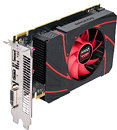- Joined
- Oct 9, 2007
- Messages
- 47,511 (7.48/day)
- Location
- Hyderabad, India
| System Name | RBMK-1000 |
|---|---|
| Processor | AMD Ryzen 7 5700G |
| Motherboard | ASUS ROG Strix B450-E Gaming |
| Cooling | DeepCool Gammax L240 V2 |
| Memory | 2x 8GB G.Skill Sniper X |
| Video Card(s) | Palit GeForce RTX 2080 SUPER GameRock |
| Storage | Western Digital Black NVMe 512GB |
| Display(s) | BenQ 1440p 60 Hz 27-inch |
| Case | Corsair Carbide 100R |
| Audio Device(s) | ASUS SupremeFX S1220A |
| Power Supply | Cooler Master MWE Gold 650W |
| Mouse | ASUS ROG Strix Impact |
| Keyboard | Gamdias Hermes E2 |
| Software | Windows 11 Pro |
AMD launched the Radeon R7 260 graphics cards, positioned in between the $139 Radeon R7 260X, and the $89 Radeon R7 250, which makes for a fairly big gap. It is expected to be priced no more than $110. Based on the same 28 nm "Bonaire" silicon as the R7 260X and the HD 7790 from the previous generation, the R7 260 is a mildly de-tuned variant of the R7 260X.
The Radeon R7 260 features just 768 of the 896 stream processors physically present on the "Bonaire" silicon. The GPU is clocked at 1000 MHz, compared to the 1100 MHz of the R7 260X; and the memory is clocked at 6.00 GHz (GDDR5-effective), compared to the 6.50 GHz of its sibling, which churns out a memory bandwidth of 96 GB/s on the chip's 128-bit wide memory bus. 1 GB, and not 2 GB is the standard memory amount. The maximum power draw is reduced to 95-Watt from 115-Watt on the R7 260X, and the card makes do with a single 6-pin PCIe power connector to draw power from. API support is consistent - DirectX 11.2, OpenGL 4.3, and Mantle. AMD TrueAudio appears to be supported.

View at TechPowerUp Main Site
The Radeon R7 260 features just 768 of the 896 stream processors physically present on the "Bonaire" silicon. The GPU is clocked at 1000 MHz, compared to the 1100 MHz of the R7 260X; and the memory is clocked at 6.00 GHz (GDDR5-effective), compared to the 6.50 GHz of its sibling, which churns out a memory bandwidth of 96 GB/s on the chip's 128-bit wide memory bus. 1 GB, and not 2 GB is the standard memory amount. The maximum power draw is reduced to 95-Watt from 115-Watt on the R7 260X, and the card makes do with a single 6-pin PCIe power connector to draw power from. API support is consistent - DirectX 11.2, OpenGL 4.3, and Mantle. AMD TrueAudio appears to be supported.

View at TechPowerUp Main Site




